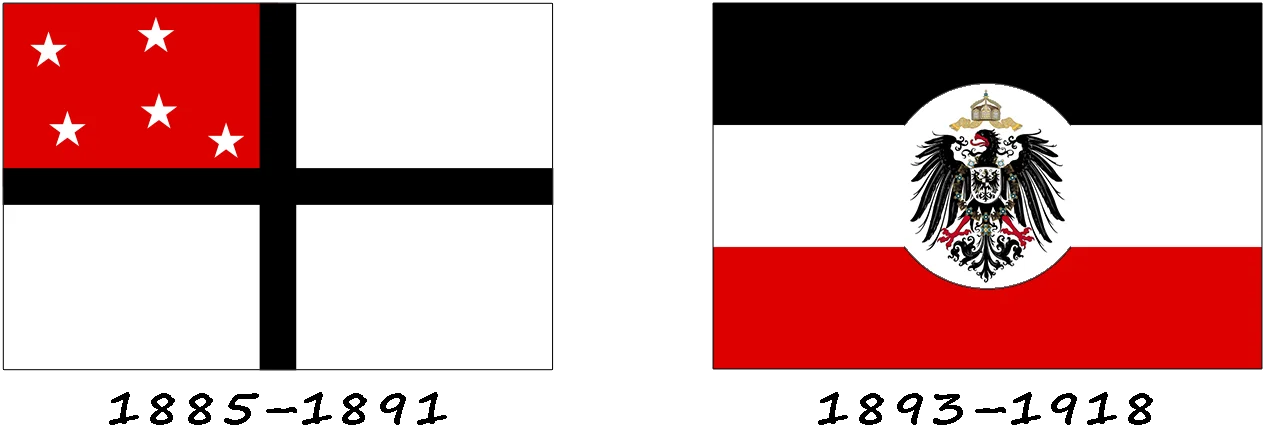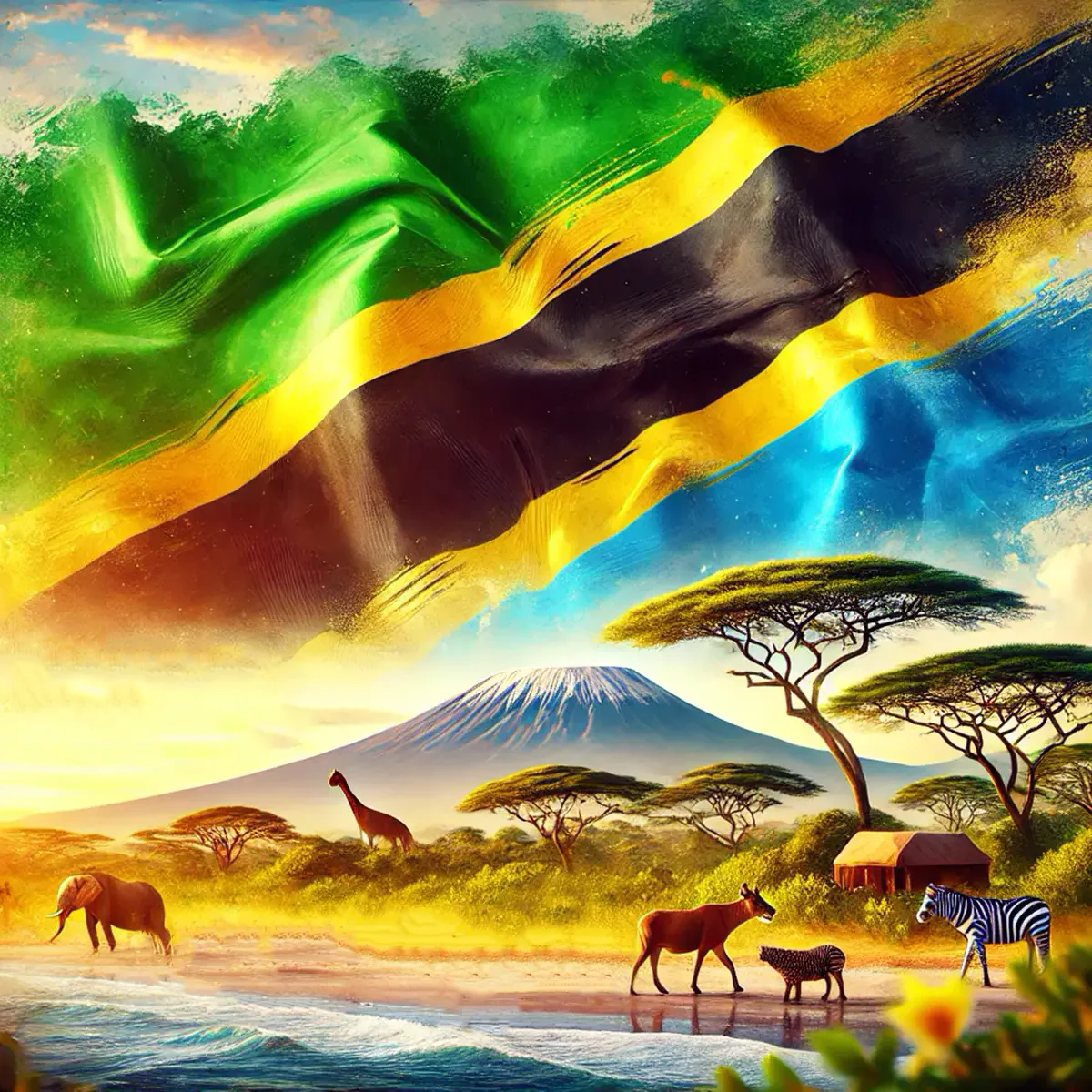The territory of modern Tanzania was home to many peoples before the arrival of European colonizers. The coast has been a center of trade since the fifth century BC, when merchants from Greece, Rome, Phoenicia, Arabia, Persia, and India traded goods with the locals. In 1498, the Portuguese Vasco da Gama became the first European to reach the coast, opening Tanzania to European explorers. In the 16th century, Portugal captured Zanzibar, but flags as state symbols did not exist during this period.
In 1885, the territory became part of German East Africa. It all began when Carl Peters, an adventurer and founder of the German Colonization Society, signed agreements with local leaders, and on March 3, 1885, Otto von Bismarck announced the creation of the protectorate. Initially, the German East African Company (DOAG) was in charge of trade, coffee and rubber cultivation, and the construction of railroads. But the harsh exploitation provoked resistance, including the Abushiri uprising of 1888-1889. In 1891, due to financial problems and the company's inability to suppress the riots, the German government took direct control, making the region a protectorate. The colony developed its economy by building ports and plantations, but suppressing uprisings, such as the Maji-Maji uprising of 1905-1907, cost thousands of lives. During the First World War, in 1916, British troops occupied most of the territory, and in 1919, under the Treaty of Versailles, Germany lost the colony. From 1885 to 1891, the company's flag was white with a black cross dividing the flag into four parts. In the upper left corner was a red square with five white stars arranged in the shape of the Southern Cross. The white color symbolized the purity of colonial ambitions, the black cross symbolized German strength, the red square symbolized bravery, and the stars indicated the colony's location in the southern hemisphere.

After 1891, the imperial tricolor became the official flag, with three horizontal stripes: black, white, and red. Black represented the unity of Germany, white the purity of imperial ideals, and red the readiness to fight. Since 1898, governors have used a tricolor with a coat of arms in the center of a white stripe-a black lion on a white background, sometimes with a palm tree, symbolizing the power of the empire and African nature. Since 1893, official buildings have flown the flag of the foreign office-a tricolor with a white disk and an imperial eagle in the center, which denoted state power. These banners flew over Dar es Salaam, but for the locals they were a sign of foreign domination.
After Germany's defeat in World War I in 1919, the League of Nations placed Tanganyika under the British mandate. The British administered the territory until December 9, 1961, when Tanganyika gained independence. In the early years of the mandate, in the 1920s, they focused on building roads, railroads, and plantations, but kept the locals in the shadow of the colonial system. In the 1930s, the first political movements began to emerge, and after World War II, in 1946, Tanganyika became a UN trust territory, which strengthened the desire for self-government. In 1954, Julius Nyerere founded the African National Union of Tanganyika (TANU), which peacefully led the country to freedom. The elections of 1958-1960 laid the groundwork for independence, when TANU won overwhelming support. The flag of this period was either the British Blue Ensign or the Red Ensign, with the Union Jack in the upper left corner on a blue background. On the right side, closer to the free edge, there was a white disk depicting a giraffe's head in natural brown and yellow shades, while on the blue flag, the giraffe's head was placed without a white disk. The blue color represented Britain's maritime power, the Union Jack its authority, and the giraffe's head symbolized the unique nature of Tanganyika, as these animals are iconic for the African savannah, embodying grace and foresight. The flag was officially introduced in 1923 and flew over government buildings, schools, and ports in Dar es Salaam until independence.

Meanwhile, from Zanzibar, in 1698, Omani Arabs drove the Portuguese out, capturing the fort and making the island part of the Omani Sultanate. Zanzibar became a center of trade in spices, slaves, and ivory, linking Arabia, India, and East Africa. Until 1856, the island prospered thanks to sea routes and clove plantations. The flag was a solid red cloth, typical of Omani rulers. The red color represented the sultan's power, military strength, and commercial power, but did not reflect the Swahili culture or the African population.
In 1856, the death of Sultan Said bin Sultan divided his empire. Zanzibar became an independent sultanate under Majid bin Said, controlling part of the East African coast. The island reached an economic peak, becoming the world leader in clove production, and the slave trade brought huge profits. The flag remained solid red, like that of Oman. In 1890, Zanzibar fell under British protectorate under the Heligoland-Zanzibar Agreement, losing its mainland territories to Germany. The Sultan remained the nominal ruler, but Britain controlled foreign policy and trade. In 1896, a 38-minute war, the shortest in history, suppressed Khalid bin Bargash's attempt to seize the throne, strengthening British rule. The flag of the sultanate remained solid red.

On December 9, 1961, Tanganyika gained independence from Britain, becoming a pioneer in the region. It was a time of reform and hope, when the country, under the leadership of Julius Nyerere, was building a new future. In 1963, Tanganyika proclaimed itself a republic, finally getting rid of the monarchy. The flag of independent Tanganyika consisted of five horizontal stripes: green, yellow, black, yellow and green. Green represented agriculture and lush nature, black represented the people of Tanganyika, and yellow represented rich mineral resources such as gold and diamonds.
On December 10, 1963, Zanzibar also gained independence from Britain as a constitutional monarchy under Sultan Jamshid bin Abdullah. But on January 12, 1964, a revolution led by the Afro-Shirazi party overthrew the monarchy, proclaiming the People's Republic of Zanzibar and Pemba. During the monarchy, the flag became red with a green disk in the center, on which were two golden carnations. The red color preserved the heritage of the sultanate, the green disk represented nature and agriculture, and the carnations represented economic pride, as Zanzibar remained the leader in their exports.

After the revolution, from January to April 1964, the flag changed to a horizontal tricolor of blue, black, and green stripes. The blue color symbolized the Indian Ocean, the black color symbolized the African population, and the green color symbolized tropical vegetation and agriculture.
On April 26, 1964, Zanzibar united with Tanganyika to form the United Republic of Tanzania. The union, led by Julius Nyerere and Abeid Karume, was to unite economic and political forces. On June 30, 1964, Zanzibar adopted the flag of Tanzania - a green upper triangle, a blue lower triangle, separated by a black diagonal stripe with yellow edges. The green color represented agriculture and nature, the blue color represented the ocean and water resources, the black color represented the people of Tanzania, and the yellow color represented mineral wealth such as gold. The diagonal design symbolized the unity of Tanganyika and Zanzibar by combining their colors in a single canvas.









